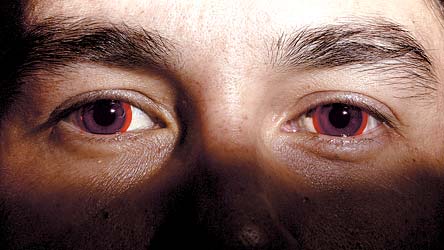Performance-enhancing contact lenses
Brian Roberts first tried on his newfangled contact lenses about an hour before the Orioles' last spring training game in Florida. He ripped three hits on a day his teammates groused about the difficulties of seeing the ball in the bright sun shining from a cloudless sky.
A longtime wearer of contacts, Roberts needed no persuading afterward to keep the new lenses, even if they make him look like some wild-eyed creature from a science fiction film. After a monster start — he entered the week hitting .444 with five homers — they might have to be pried away from him.
Plenty has been said about performance-enhancing drugs this spring. Well, get ready for a new wave of performance enhancers, only these do not cause side effects and are not subject to suspensions. Known as performance-enhancing contact lenses, they were designed to help hitters pick up the seams on the ball better and to protect the eyes from the sun.
"They're almost like wearing sunglasses without wearing sunglasses," Roberts says. "I could tell such a huge difference right away that I was willing to give them a shot." Seven years in the making by Nike and Bausch & Lomb, the lenses — which will be known in the retail world as MaxSight — are so new they have made their way only into a few major league clubhouses so far.
Roberts, the Orioles' leadoff hitter and second baseman, is the only player the Sporting News could confirm is wearing them in games. Reds center fielder Ken Griffey has tried them in batting practice and plans to break them out for real once he becomes more comfortable with them. Reds closer Danny Graves also is wearing them during pregame work. Red Sox pitchers Bronson Arroyo and Mike Timlin and Twins catcher Joe Mauer have been fitted.
Tennis player Roger Federer and several D.C. United soccer players have agreed to try them. The University of Miami has 20 athletes on its football, baseball, tennis and track teams wearing them. The lenses also come in gray-green for golfers, and a set for night use is in the final stages of development.
But for now, the version that's part orange and yellow with a hint of red — amber, to be precise — remains mainly in the testing stages for the pros.
Roberts doesn't wear them all of the time, so don't credit his hot start solely to his high-tech eyewear. His amber set is of no use at night, when he plays most of his games. But none of the dozen or so players who had been fitted by last week has turned them back in.
"It helps your eyes relax instead of squinting all the time," Graves says, "and that helps relax the rest of your body."
Roberts and Graves have worn contact lenses for years, so their adjustment is not the same as it is for someone who never has worn glasses or contacts, such as Griffey.
"It took me about 15 minutes to put them in the first time," Griffey says. "I'm still getting used to having something on my eyes."
Even though Griffey has been a bit slow testing the amber lenses, he was counting the days until a Reds off day so he could try his gray-green set on the golf course. The gray-greens — used in stationary sports; the ambers are geared for speed sports — allow golfers to better differentiate the shades of green on a course.
Golfer Justin Leonard has a pair of sunglasses with gray-green lenses, and he told Nike he is able to separate out every blade of grass. For baseball players, because amber blocks out blue light, "visual noise" to vision experts, red colors, such as a baseball's seams, are accentuated.
There are medical advantages as well to wearing the lenses, which basically are soft contacts with a tint that has been scientifically developed. While light can leak through sunglasses, through the opening between the frame and the eyes, performance-enhancing contacts sit on the pupils and better protect them from the sun.
Because baseball players are exposed to so much sunlight, some of them — Timlin, for one — develop a condition called pterygium that, essentially, causes a callus-type film to form on the cornea, leading to dryness in the eyes.
"Most important, we want our athletes to continue to see their sport better and better for longer and longer," says Tony Chipote, a marketing field manager for Nike. "As soon as you start to lose your eyesight, the rest of your body will start to suffer. When you have those guys whose reflexes are cat-quick, they're that way based first on what they're seeing."
When MaxSight hits the market this summer, the sets will be sold at vision care centers, not sporting goods stores. They will be available in prescription and nonprescription lenses and will cost about the same as regular contact lenses. They have a life of about three to four weeks, depending on how often they are worn.
They're not for everyone. When Cardinals left fielder Reggie Sanders was told of their attributes, he rolled his eyes. "OK, sure," he said in a "What will they think of next?" tone.
Shortstop David Eckstein says he is unlikely to try them simply because he can't stand the idea of putting something directly on his eyes. Slugger Albert Pujols turned down an invitation to try them.
But plenty of others are excited at the prospects. When Nike made its spring training stop in Fort Myers, Fla., it found Twins outfielders Torii Hunter and Jacque Jones were "superexcited" about trying them. But before they could get checked out by a vision specialist, manager Ron Gardenhire was shooing the Nike reps out of the clubhouse because the team was almost ready to take the field for an exhibition.
"We'll get back to them," says Chipote, who spent spring training visiting the clubs that train in Florida.
While it seems hitters would gain a bigger advantage from the lenses, there's an edge or two that can be gained by pitchers. For one, pitchers can't wear sunglasses on the mound, so the performance-enhancing contacts give them a way to fight the sun's glare. Just as important, there can be an intimidation factor: Imagine looking out at a pitcher and seeing two bright amber eyes staring back.
"They make you look kind of evil," Graves says. "Hitters might look at you like you're possessed."
Until the night lenses are available, anyway. Those are expected to be lighter and a little less menacing-looking. Roberts, for one, also expects them to be much more popular.
"Because so many games are played at night, I'm not sure if these will take off," he says of the amber version. "But the most popular ones would be the ones in the works for night games. There won't be a phenomenon until then."
That will be a sight to see, through any colored lenses.



0 Comentarios:
Publicar un comentario en la entrada
<< Volver